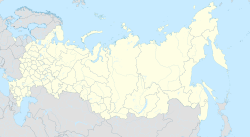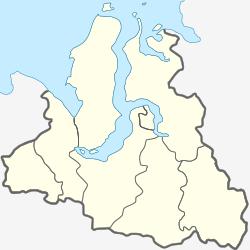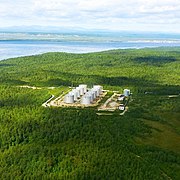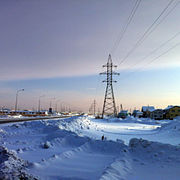
The Yamalo-Nenets Autonomous Okrug or Yamalia is a federal subject of Russia and an autonomous okrug of Tyumen Oblast. Its administrative center is the town of Salekhard, and its largest city is Novy Urengoy. The 2021 Russian Census recorded its population as 510,490.

Nadym is a town in Yamalo-Nenets Autonomous Okrug, Russia, located on the river Nadym. The population has fluctuated over time: 46,611 (2010 Census); 45,943 (2002 Census); 52,586 (1989 Soviet census).

Noyabrsk is the second largest city in Yamalo-Nenets Autonomous Okrug, Russia, located in the middle of the West Siberian oil fields, on the Tyumen–Novy Urengoy railway about 300 kilometers (190 mi) north of Surgut. Population: 110,620 (2010 Census).

Novy Urengoy is a city in Yamalo-Nenets Autonomous Okrug, Russia. Population: 107,251 (2021 Census); 104,107 (2010 Census); 94,456 (2002 Census); 93,235 (1989 Soviet census). It is the largest city in the autonomous okrug.

Tarko-Sale is a town and the administrative center of Purovsky District in Yamalo-Nenets Autonomous Okrug, Russia. It is located on the Pyakupur River near its confluence with the Ayvasedapur river, 560 kilometers (350 mi) southeast of Salekhard the administrative center of the autonomous okrug. The population of Tarko-Sale was 20,398 (2010 Census); 18,517 (2002 Census); 17,400 (1989 Soviet census).

Muravlenko is a town in Yamalo-Nenets Autonomous Okrug, Russia, located 480 kilometers (300 mi) southeast of Salekhard. Population: 33,391 (2010 Census); 35,926 (2002 Census).

Labytnangi is a town in Yamalo-Nenets Autonomous Okrug, Russia, located on the left bank of the Ob River, 20 kilometers (12 mi) northwest of Salekhard. Population: 26,936 (2010 Census); 27,304 (2002 Census); 31,501 (1989 Soviet census).

Gubkinsky is a town in Yamalo-Nenets Autonomous Okrug, Russia, located on the left bank of the Pyakupur River, south of Salekhard. Population: 23,335 (2010 Census); 20,407 ; 9,676.
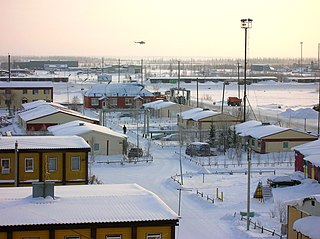
Nadymsky District is an administrative and municipal district (raion), one of the seven in Yamalo-Nenets Autonomous Okrug of Tyumen Oblast, Russia. It is located in the central and southern parts of the autonomous okrug. The area of the district is 103,960 square kilometers (40,140 sq mi). Its administrative center is the town of Nadym. Population: 19,919 ; 23,470 (2002 Census); 29,772 (1989 Soviet census).

Gubkinsky Urban Okrug is the name of several municipal formations in Russia:
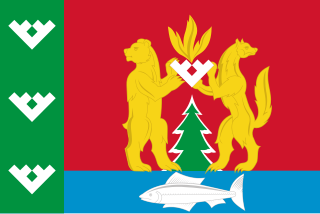
Krasnoselkupsky District is an administrative and municipal district (raion), one of the seven in Yamalo-Nenets Autonomous Okrug of Tyumen Oblast, Russia. It is located in the southeast of the autonomous okrug. The area of the district is 106,270 square kilometers (41,030 sq mi). Its administrative center is the rural locality of Krasnoselkup. Population: 6,204 ; 6,384 (2002 Census); 7,940 (1989 Soviet census). The population of Krasnoselkup accounts for 64.1% of the district's total population.

Priuralsky District is an administrative and municipal district (raion), one of the seven in Yamalo-Nenets Autonomous Okrug of Tyumen Oblast, Russia. It is located in the west of the autonomous okrug. The area of the district is 64,150 square kilometers (24,770 sq mi). Its administrative center is the rural locality of Aksarka. Population: 14,995 ; 7,680 (2002 Census); 6,616 (1989 Soviet census). The population of Aksarka accounts for 20.9% of the district's total population.

Purovsky District is an administrative and municipal district (raion), one of the seven in Yamalo-Nenets Autonomous Okrug of Tyumen Oblast, Russia. It is located in the center and south of the autonomous okrug. The area of the district is 108,400 square kilometers (41,900 sq mi). Its administrative center is the town of Tarko-Sale. Population: 51,280 ; 47,667 (2002 Census); 56,049 (1989 Soviet census). The population of Tarko-Sale accounts for 39.8% of the district's total population.
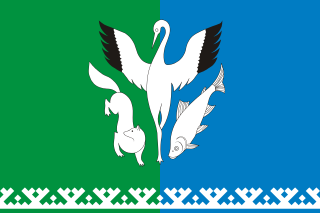
Shuryshkarsky District is an administrative and municipal district (raion), one of the seven in Yamalo-Nenets Autonomous Okrug of Tyumen Oblast, Russia. It is located in the southwest of the autonomous okrug. The area of the district is 54,016 square kilometers (20,856 sq mi). Its administrative center is the rural locality of Muzhi. Population: 9,814 ; 9,559 (2002 Census); 9,001 (1989 Soviet census). The population of Muzhi accounts for 36.8% of the district's total population.
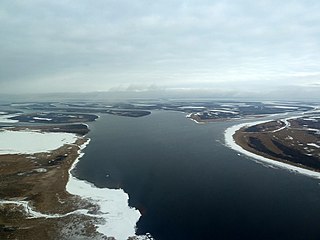
Tazovsky District is an administrative and municipal district (raion), one of the seven in Yamalo-Nenets Autonomous Okrug of Tyumen Oblast, Russia. Its administrative center is the rural locality of Tazovsky.

Yamalsky District is an administrative and municipal district (raion), one of the seven in Yamalo-Nenets Autonomous Okrug of Tyumen Oblast, Russia. It is located in the north and northwest of the autonomous okrug. The area of the district is 117,410 square kilometers (45,330 sq mi). Its administrative center is the rural locality of Yar-Sale. Population: 16,310 ; 14,918 (2002 Census); 15,029 (1989 Soviet census). The population of Yar-Sale accounts for 39.8% of the district's total population.
Zapolyarny Urban Settlement is the name of several municipal formations in Russia.
The Anthem of the Yamalo-Nenets Autonomous Okrug is one of the national symbols of Yamalo-Nenets Autonomous Okrug, a federal subject of Russia, along with its flag and coat of arms. The Russian lyrics of the anthem were written by Lyudmila Khodunova, and the anthem's music was composed by Yuri Yunkerov, both in 2010. It was officially adopted on 17 November 2010.

Yar-Sale is a rural locality in Russia located east of Salekhard near the Gulf of Ob in the northern part of Western Siberia. It is the administrative center of Yamalsky District, one of seven in Yamalo-Nenets Autonomous Okrug of Tyumen Oblast.

Aksarka is a rural locality and the administrative center of Priuralsky District of Yamalo-Nenets Autonomous Okrug, Russia. Population: 3,133 (2010 Census); 2,569 (2002 Census); 2,365 (1989 Soviet census).




